
Vanua Levu, formerly known as Sandalwood Island, is the second largest island of Fiji. Located 64 kilometres to the north of the larger Viti Levu, the island has an area of 5,587.1 square kilometres (2,157.2 sq mi) and a population of 135,961 as of 2007.

Tavua is a town in Fiji, 91 kilometres from Nadi and 9 kilometres from the gold mining settlement of Vatukoula. It was formally incorporated as a Town in 1992 with the appointment of its first Mayor, Iliesa Vula from Tavualevu. The town covers a land area of 100 square kilometres, and had a population of 2,418 at the 1996 census.
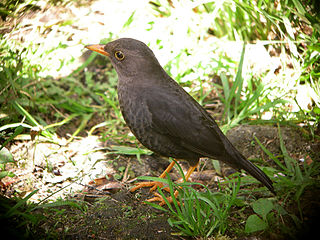
The island thrush is a common forest bird in the thrush family. Almost 50 subspecies have been described, ranging from Taiwan, through South East Asia and Melanesia, to Samoa, exhibiting great differences in plumage. Several subspecies are threatened and three have already become extinct.
Degeneria is a genus of flowering plants endemic to Fiji. It is the only genus in the family Degeneriaceae. The APG IV system of 2016, recognizes this family, and assigns it to the order Magnoliales in the clade magnoliids.

The giant Fijian long-horned beetle is native to the island of Viti Levu in Fiji, and is one of the largest living insect species, with specimens around 15 cm long, excluding legs, antennae, or jaws. It is closely related to the Taveuni beetle, which is only marginally smaller. These beetles have powerful jaws, and should be handled with care when alive—when threatened, they produce a loud and fearsome hissing noise by squeezing air out from under their elytra. Various websites and other resources incorrectly indicate that this species is extinct; it is not, though the forest habitat on its home island is somewhat limited, so the beetle is potentially quite vulnerable.
The long-legged thicketbird is a small bird endemic to Fiji. The species is sometimes known as the long-legged warbler. It was formerly classified as the sole representative of the genus Trichocichla.
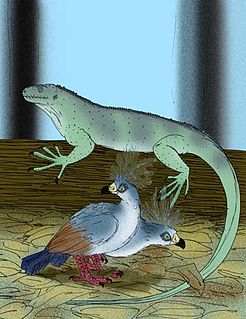
The Viti Levu giant pigeon or Fiji giant ground pigeon is an extinct flightless pigeon of Viti Levu, the largest island in Fiji. It was only slightly smaller than the dodo and Rodrigues solitaire and is the first giant, flightless pigeon to be discovered on a Pacific island.

The Fiji parrotfinch is a species of estrildid finch endemic to Fiji that was formerly considered to be a subspecies of the red-headed parrotfinch. This parrotfinch is a small, mainly green bird with a red head and tail and a stubby dark grey bill. It is found in both forested and open habitats, and has adapted well to man-made environments such as grasslands, pasture and gardens. Pairs have a courtship display in which they fly above the trees in an undulating flight, calling constantly. Breeding birds build a domed grass nest with a side entrance, and lay a clutch normally of four white eggs. Newly hatched chicks are naked and pink, with blue balls at the upper and lower corners of the gape, and black markings inside the mouth; older fledglings resemble the adults, but lack the red head colouring. The Fiji parrotfinch eats seeds, especially of grasses, and also readily feeds on insects and nectar. It forms small flocks of up to six birds after the breeding season.

The pink-billed parrotfinch is a species of estrildid finch found on the island of Viti Levu, Fiji. Commonly found at undisturbed mature forest in the centre and east of Viti Levu, e.g. Joske's Thumb near Suva. This species is found at mid-height along tree-trunks and branches, usually alone or in pairs but also joining mixed-species flocks, feeding primarily on insects, but also on flower buds and fruits.

The Fiji goshawk is a species of bird of prey in the family Accipitridae. It was once considered to be the same species (conspecific) as the brown goshawk of Australia and New Caledonia. It is endemic to Fiji, where it occurs on the larger islands of Viti Levu, Vanua Levu, Taveuni, Kadavu, Gau and Ovalau. It occupies a range of wooded habitats in Fiji, from natural rainforest to coconut plantations and urban gardens and parks.
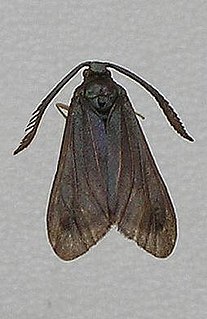
The levuana moth was a species of moth in the family Zygaenidae. It is monotypic within the genus Levuana.
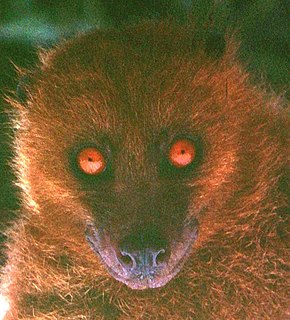
The Fijian monkey-faced bat or Fijian flying fox is a megabat endemic to Fiji. It was discovered in old-growth cloud forest on Des Vœux Peak, the second highest mountain peak on the island of Taveuni by William and Ruth Beckon in 1976, and is Fiji's only endemic mammal. It has recently been transferred from Pteralopex to its own monotypic genus Mirimiri.

Cephalotes alveolatus is an extinct species of ant in the subfamily Myrmicinae known from a single Middle Miocene fossil found in amber on Hispaniola. At the time of description C. alveolatus was one of seven fossil ant species placed in the Cephalotescoffeae clade.
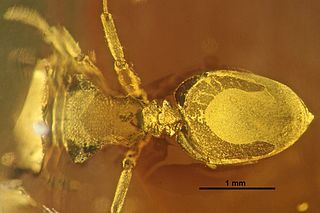
Cephalotes hispaniolicus is an extinct species of ant in the subfamily Myrmicinae known from a single Middle Miocene fossil found in amber on Hispaniola. At the time of description C. hispaniolicus was one of six ant species placed in the Cephalotesmultispinosus clade.
The noble megapode, also known as the deep-billed megapode, is an extinct, flightless, giant stem-galliform bird that was endemic to Fiji. Originally thought to be a megapode, more recent morphological studies indicate a close relationship with Sylviornis, in a clade outside of the Galliformes crown group. It is likely that it became extinct through overhunting shortly after the colonisation of the Fiji Islands by humans.

Proceratium is a rare genus of ants in the subfamily Proceratiinae. It is the type genus of the tribe Proceratiini, which in addition to Proceratium consists of two even rarer genera: the extant Discothyrea and the fossil genus Bradoponera.
Pristomyrmex tsujii is a species of ant in the genus Pristomyrmex. Known from Fiji, where they are widely distributed but rarely encountered. The species has a discrete ergatoid queen caste that is intermediate between a worker and an alate queen.

Proceratium eocenicum is an extinct species of formicid in the ant subfamily Proceratiinae known from fossils found in the Baltic region.
Ba humbugi is the only species and therefore the type species in the genus Ba, a genus of land snail, belonging to the family Charopidae. Both the genus and the species were named by the American malacologist Alan Solem. The genus is endemic to the Fijian island of Viti Levu, and B. humbugi is an endangered species.



















